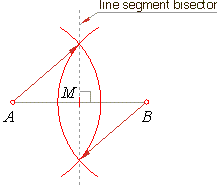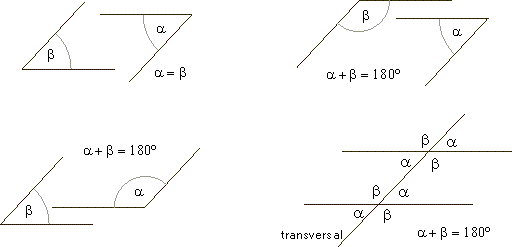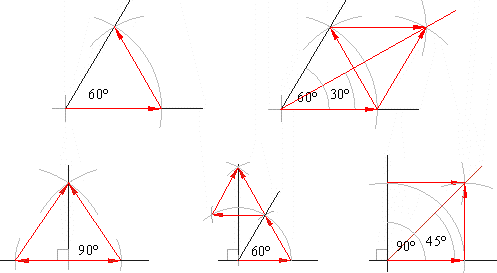|
| Geometry |
|
|
|
Sets of
Points in a Plane
|
 Line, a half-line and line segment
Line, a half-line and line segment
|
 The line segment bisector
The line segment bisector
|
 Angle, measurement of angles
Angle, measurement of angles
|
 Complementary, supplementary,
alternate and vertically opposite angles
Complementary, supplementary,
alternate and vertically opposite angles
|
 Angle bisector
Angle bisector
|
 Construction of angles; 60°, 30°, 90°
and 45° (degrees)
Construction of angles; 60°, 30°, 90°
and 45° (degrees)
|
|
|
|
|
|
|
|
| Line, a half-line and line segment
|
| Line is a straight one dimensional geometrical figure of infinite
length. |
| Any
pair of points uniquely determine a line, of which the segment
between given points is the shortest path between them. |
| The
intersection
point A is a common point of two lines. |
| A line divides a plane into two
half-planes. |
|
|
|
|
| Two lines are called
parallel lines, if they lie in the same plane and don’t intersect. |
| The point
A
which lies on a line divides the line into the two half-lines (rays). |
| The part of a line between two points is called a
line segment. The line segment AB
is the part of the line
l. |
|
|
|
|
| The line segment bisector
|
| The line segment bisector crosses the segment through the
midpoint, forms a right angle and each of its points is equidistant from the segment's endpoints. |
|
 |
|
|
| Angle, measurement of angles
|
| Angle is the figure formed by two half-lines or rays OA and OB
(sides of an angle) sharing a common endpoint O
called the vertex of the angle. An angle is signed AOB. |
|
|
|
|
 |
|
| The unit of angles measure is a degree,
1° (deg). The angle of a
full circle (complete revolution) equals 360 degrees. |
| One degree is divided by 60 minutes,
1° = 60', one minute by 60 seconds,
1' = 60". |
|
 |
|
| Complementary, supplementary,
alternate and vertically opposite angles
|
| Complementary angles are two angles that have the common
vertex, one common side and whose sum is 90 degrees. |
| A sum of
supplementary (adjacent) angles is equal to 180 degrees. |
| Any
pair of angles formed between two intersecting lines and lying
on the same side of one of them are called adjacent angles.
The adjacent angles of two intersecting lines supplement each
other. |
| Two
angles having a sum of 360 degrees are called conjugate
( or explementary) angles. |
|
 |
|
| When two lines intersect at one point, they form four angles. The
opposite angles on the figure above are called vertical angles. Vertical angles have the same measure. |
| Angles with correspondingly
parallel sides either are equal one to another, or sum of them is 180
degrees. |
| Parallel lines intersected by a transversal
(traverse) form the angles which are equal or supplementary. |
|
 |
|
| The angles contained between two given lines lying on opposite
sides of the transversal are called alternate angles. |
| Two angles
with mutually perpendicular sides are equal or supplementary. |
|
 |
|
| Angle bisector
|
| An
angle bisector is a straight line that divides an angle into two
equal angles. |
|
 |
|
| Construction of angles; 60°, 30°, 90°
and 45° (degrees)
|
|
 |
|
|
|
|
|
|
|
|
|
|
|
|
| Geometry
and use of trigonometry contents - A |
|
|
 |
|
| Copyright
© 2004 - 2020, Nabla Ltd. All rights reserved. |